DISC interpretation Dos and Don’ts
Adam Stamm
Managing Partner: Online DISC Profile
The Dos & Don'ts of DISC Interpretation and Use
DISC can help you uncover lots of valuable insights. However, there are limitations to the model and correct ways to use the information.
I will combine our 40 years of experience with perspectives and research in organizational, leadership, and professional development to show you how to interpret DISC results and use them effectively.
DISC is a powerful model for learning more about yourself and others. Through DISC, you can learn your:
- Motivations
- Stressors
- Communication Preferences
- Leadership Styles
- And more!
DISC can help you uncover lots of valuable insights. However, there are limitations to the model and correct ways to use the information. This article will provide guidance on using DISC correctly.
If you haven’t completed a DISC Profile yet, we invite you to complete our free DISC Profile to learn more about yourself and others.
DON'T use DISC These Ways
In every DISC Training workshop we run, learners exclaim how much their DISC results resonate with them.
It’s hard for them to believe that a 20-minute assessment can produce such accurate results. This is a common experience that many DISC-using companies have shared with us.
The typical next step after a learner digests the information about themselves is to learn the DISC style of their co-worker, manager, partner, or family member. After all, it’s only natural to consider new information from those we know well.
This common situation leads us to our first ‘don’t’ in using DISC.
Don't Diagnose Someone with a DISC Style
Because DISC is a simple model, it’s easy to believe that it can be used to determine a friend, spouse, or family member’s DISC style without having them take the assessment themselves.
We don’t recommend using DISC this way. It’s important to remember that DISC is a self-assessment using a complex algorithm to identify someone’s behavioral style.
I like to use an analogy of someone’s demographics to help explain this complexity.
You could tell me that your co-worker is American. That would help me understand some general ideas about them. It would allow me to predict what language they may speak, some of their ideologies, and cultural preferences.
However, they might self-identify as Italian-American. Furthermore, they might say they are from Northern New Jersey. If you are familiar with Italian-Americans who live in northern New Jersey, you would have a completely different perspective of who someone is compared to your average American, and this would give you a better basis of understanding someone’s perspective.
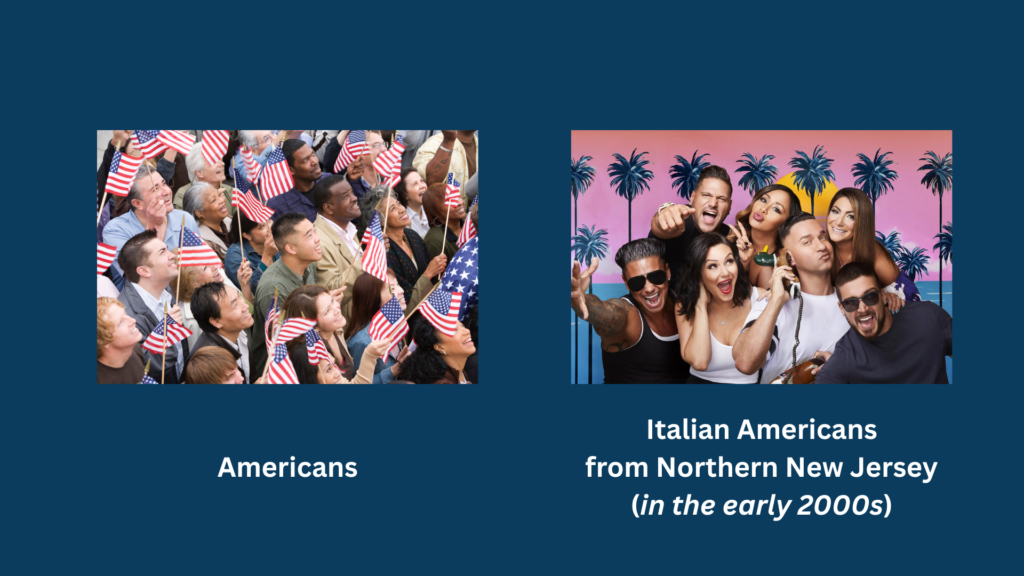
Similarly to DISC, you might notice one aspect of someone’s style because it matches your style or because they have the opposite style, which can cause personality friction.
What you are identifying may blind you to their unique personality and cause you to box them into a description that isn’t entirely accurate. By allowing someone to self-identify their style, you can discuss their behavioral needs and stressors in greater depth.
The founder and owner of our organization, Rick Stamm, started using DISC in 1986. He likes to say, “DISC is something you do WITH people, not TO people.” Rather than assuming you know someone’s personality style, allow them to take the free DISC assessment and ask them these questions:
- How do you see your personality style come up during your day?
- Is there something you disagree with regarding your results?
- What do you agree with in your results?
These questions invite a conversation around personality styles rather than a diagnosis. It creates a much more powerful learning conversation and helps build your relationship.
In fact, these questions may actually help the person you are speaking with understand themselves better! It seems odd, but we are all going through a self-discovery process throughout our lives, and researchers in Israel have found that a great listener can help facilitate it.
Now, you might ask how you should ask someone like your boss, a customer, or someone with whom you are experiencing conflict to complete a DISC profile so you can have this conversation. Don’t worry; I know this could be a difficult question to ask somebody.
We will introduce a concept we call ‘People Reading’ later in this article. I’ve written a whole section on that subject. If you want to skip ahead to read more on the subject, you can read here –>
Don’t Reduce Someone To Their DISC Style
Personality is complex. DISC offers insights into areas that frequently invite interpersonal conflict. It can help explain motivations and stressors, but it should never be used to excuse someone’s behavior or to pigeonhole someone.
We mentioned that DISC should be used with others. However, there are right and wrong ways to do this.
Below are a few statements that help shed light on the wrong way to use DISC with others:
- He can’t be direct. He’s an “S” after all.
- Don’t expect me to listen. I’m a “D.”
- She’ll never enjoy the party. She’s a “C.”
- I am an “I.” I just can’t sit and look at a computer all day.
We call these statements DISC Misuses. You can take our quiz on it to learn how not to misuse quizzes and appreciate the complexity of people.
When using DISC for professional development or coaching, we encourage learners to find out if they are using DISC correctly.
Don’t Mistake What DISC Does and Doesn’t Measure
DISC is often used within the hiring process.
From a hiring manager’s perspective, it’s affordable and easy to understand. The insights are helpful during the interview process and for onboarding new hires. For candidates, it’s a short assessment that doesn’t take too much time, making it an excellent assessment to use during this process.
However, we caution organizations and hiring managers not to reduce someone to only their DISC style. While DISC offers powerful insights, it does have limitations.
DISC only measures a person’s personality based on their behaviors, stressors, and motivations. It doesn’t measure a person’s cognitive abilities or interests. It’s important not to assume that specific characteristics are represented.
For example, you might want to hire a salesperson and use DISC to find candidates with a DI/ID personality type. While someone with this personality might be successful, it’s important not to assume it is only based on their personality. Their experience in sales, problem-solving ability, or even their interest in selling your products might be more indicative of their success than their DISC profile. It’s also possible that your particular product could be an easier sell for a DISC style you didn’t expect (there are 12 styles, after all!).
When using any assessment within the hiring process, it’s important to know what you are measuring. Our DISC research article explains the DISC Model’s measurements.
Does DISC Measure Emotional Intelligence?
DISC does not measure someone’s emotional intelligence capabilities, but it does identify aspects of our core psychological needs. DISC can be used in a conversation about emotional intelligence because it can help you understand why certain social and emotional situations occur.
For example, when lots of changes are occurring at work, a person with the D-Style might respond emotionally if they feel their status or authority is being taken away.
This is a core psychological need of this style. If a change isn’t communicated effectively (or at least how it will affect a D-Style’s sense of authority), they may react emotionally.
To go deeper into emotional intelligence and DISC, check out the product DISC Awareness, which measures both DISC and a person’s EQ.
This combined report can help facilitate a fuller discussion of emotional intelligence by bringing personality insights to topics in emotional regulation.
DO Use DISC These Ways
All right, we’ve gotten through the ways you shouldn’t use DISC. Now, let’s focus on how you should use DISC.
Do Use the Platinum Rule with DISC
You may have heard of the Golden Rule, which says, “Treat others as you would want them to treat you.”
This is wise advice. However, when using DISC, we take it a step further. We advise learners to use the Platinum Rule: “Treat others as they wish to be treated.”
The rules are pretty similar, but the difference is enormous. In the Golden Rule, you consider yourself and treat others how you want to be treated. Most expect others to respect us, so this rule is a good starting point. The Platinum Rule asks you to consider others’ needs and meet them.
This puts the needs of others before your own.
There is extensive research to support this method. Adam Grant is a professor of Psychology at the Wharton Business School at the University of Pennsylvania. Grant wrote a book titled Give and Take, in which he categorized people into three groups: Givers, takers, and matchers. Givers were people who put others before themselves and openly shared knowledge and their expertise. They went beyond meeting someone halfway—they put others’ needs before their own.
Grant found that these individuals were more successful, more easily promoted, and earned more than those who were found to be matchers or takers.
If the Platinum Rule feels like you are giving too much, research suggests it’s a better strategy overall and will help you more in the long run.
Do Consider Adaptability with DISC
The DISC Assessment measures the intensity of adaptability between behavioral styles.
As an example, not every S-Personality type person is the same. They can have two very different personality types depending on how high or low their graph is and how high or low the other three styles are.
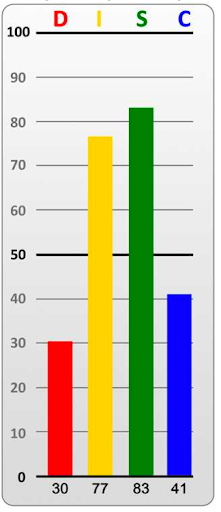
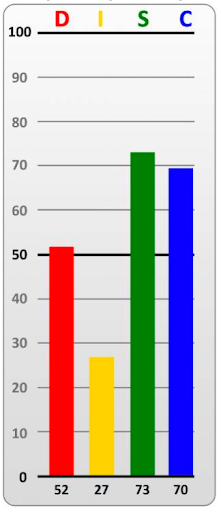
DISC shows how hard or easy it might be for a person to choose a particular behavior that doesn’t match their personality style. We call this ability to choose certain behaviors ‘stretching.’ For the first graph, stretching toward D-Personality Type behaviors might be harder than the second. The distance between each bar graph for the D-Style is 20 points different.
In fact, William Moulton Marston, the theorist of the DISC model, wrote in his book Emotions of Normal People that his vision of the model was represented as a color wheel. The wheel would show a person’s primary color as identified in the model but also the other colors that are part of their personality.
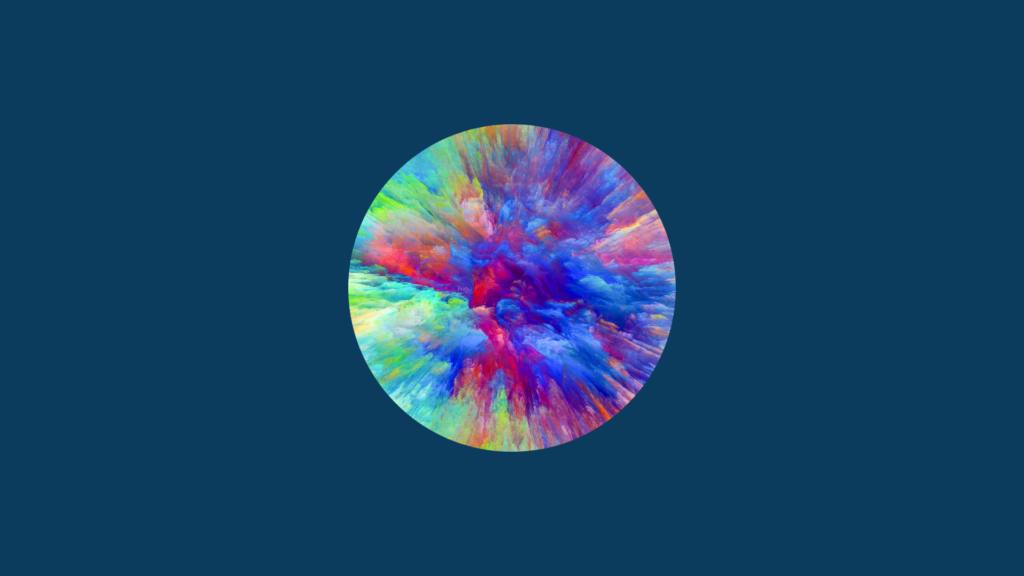
We all have the capacity to engage in behaviors beyond our DISC Style. It’s important to remember this and to not reduce someone down to their primary DISC letters.
Do Consider Ontological Humility
Ontological Humility holds that everyone has valid perspectives and that there can be more than one truth.
Fred Kofman outlined this idea in his book Conscious Business. Kofman is a professor of management information systems at the MIT Sloan School of Management.
This idea is central to implementing DISC successfully as part of an organization’s culture. One of the first activities during a DISC workshop engages in this idea. After we cover the central concepts of the DISC Model, we provide learners with their Full DISC Profile report and ask them to read their DISC Story within the report and complete the Personalizing Their Report activity.
During this activity, we ask learners to underline statements they agree with, cross out statements they disagree with, and place question marks on statements they are unsure about or have questions about. This simple process allows a learner to validate their perspective of themselves within the report.
After all, because DISC is a self-assessment, the learners know more about themselves than the assessment does. It’s also possible that someone’s assessment results have changed since they took the assessment! Finally, certain statements in their report might resonate in only certain circumstances (i.e., at work versus at home).
It’s essential to allow space for this discussion so a person can share what they know about themselves. It’s also an excellent way for them to get feedback from others who can provide valuable insights into blind spots.
Do Use DISC to People Read
Consider the behavior of an excellent salesperson for a moment.
A great sales person can listen effortlessly for verbal or physical cues that respond to what they are presenting. Next, they try to anticipate how they can change what they say to produce a

Key Take Aways & How to Get Started
We covered a lot in this article!
If you are looking for a list of key concepts you should remember, here they are:
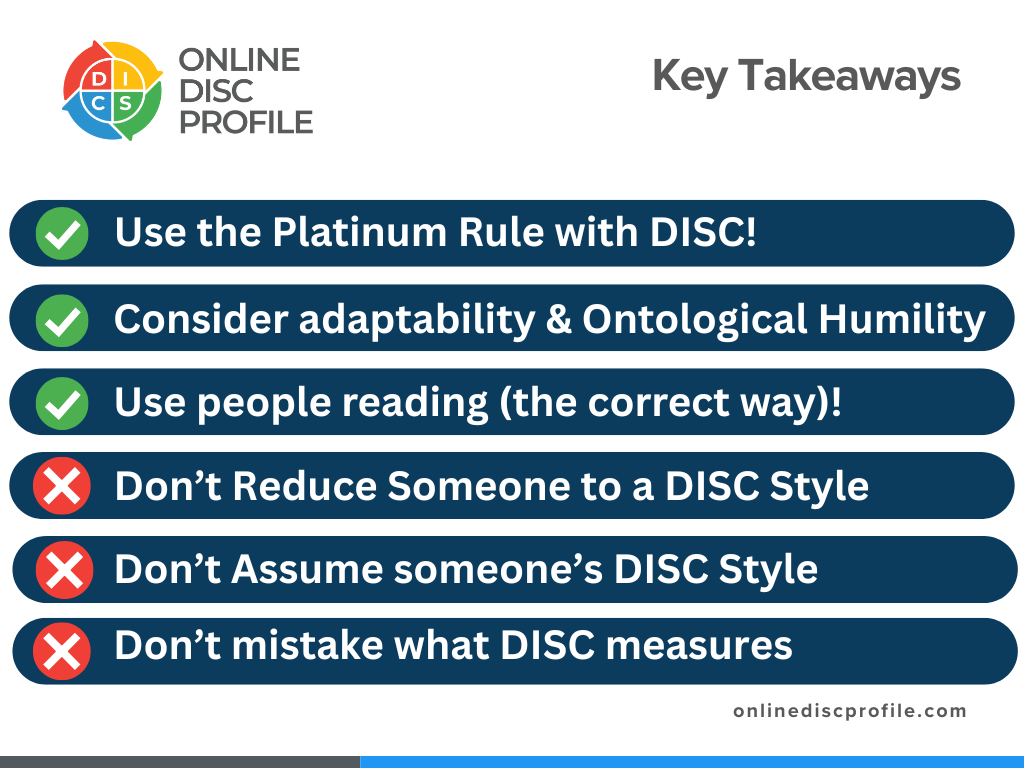
Now that we’ve covered some of the most basic do’s and don’ts of DISC, you might be wondering how to start using DISC.
Before I provide some directions, I’ll first ask you how you plan to use DISC and to identify where you fall by looking at the list below:
- I want to use DISC to learn more about myself.
- I want to use DISC to teach others more about themselves.
- I want to use DISC within my team or organization.
Feel free to click on the section that best describes your goal in using DISC. Don’t hesitate to contact us if you feel none of these options fit how you want to use DISC.
How to take a DISC Profile for Yourself
If you want to take a DISC Profile to learn more about yourself, we encourage you to take our Free DISC Profile. This assessment allows you to complete the full DISC assessment and get a simple profile explaining your DISC Strengths.
After you have completed this assessment, you will have the chance to purchase the full DISC Profile.
After you finish the assessment, you will be automatically signed up for a multi-week email series where we will further teach you about DISC and how to use your results. Don’t worry; you can unsubscribe at any time.
How to teach DISC to others
If you want to use DISC within a course that you teach or within an HR or Professional Learning program, we want to encourage you to become certified in DISC. Our DISC Training Certification teaches the foundations of DISC Theory and the Model. It covers common questions that learners have about the process and provides you with resources and education to teach DISC.
This course includes access to our support team for ongoing support as well.
How to use DISC with teams or organizations
If you are a team leader or HR professional wanting to bring DISC to your team or organization, we offer virtual and in-person training programs to help you establish DISC concepts.
DISC helps improve organizational culture by helping shed light on interpersonal issues and conflict. Our training staff are highly trained and available for both workshop-based training and 1:1 coaching.

